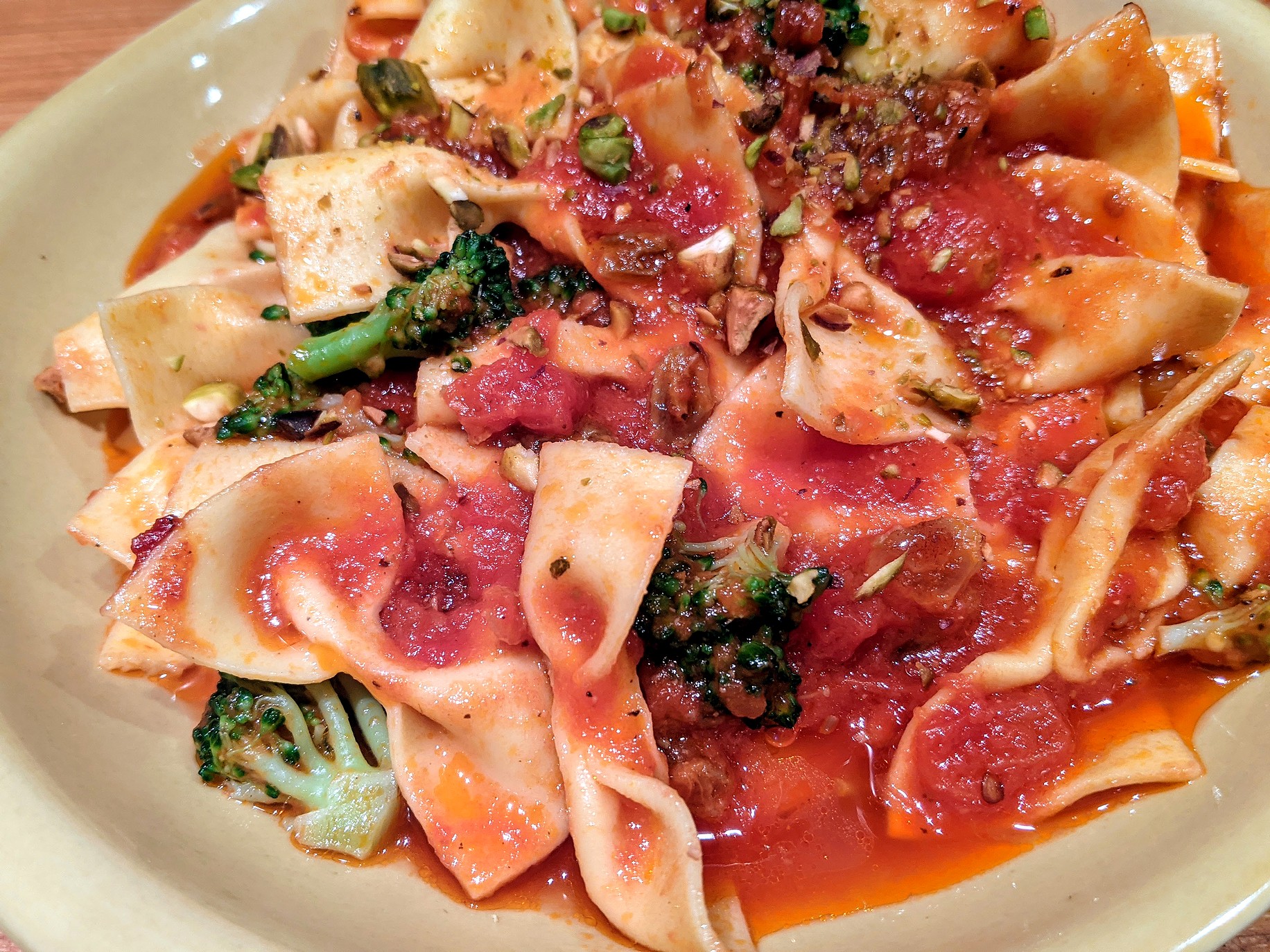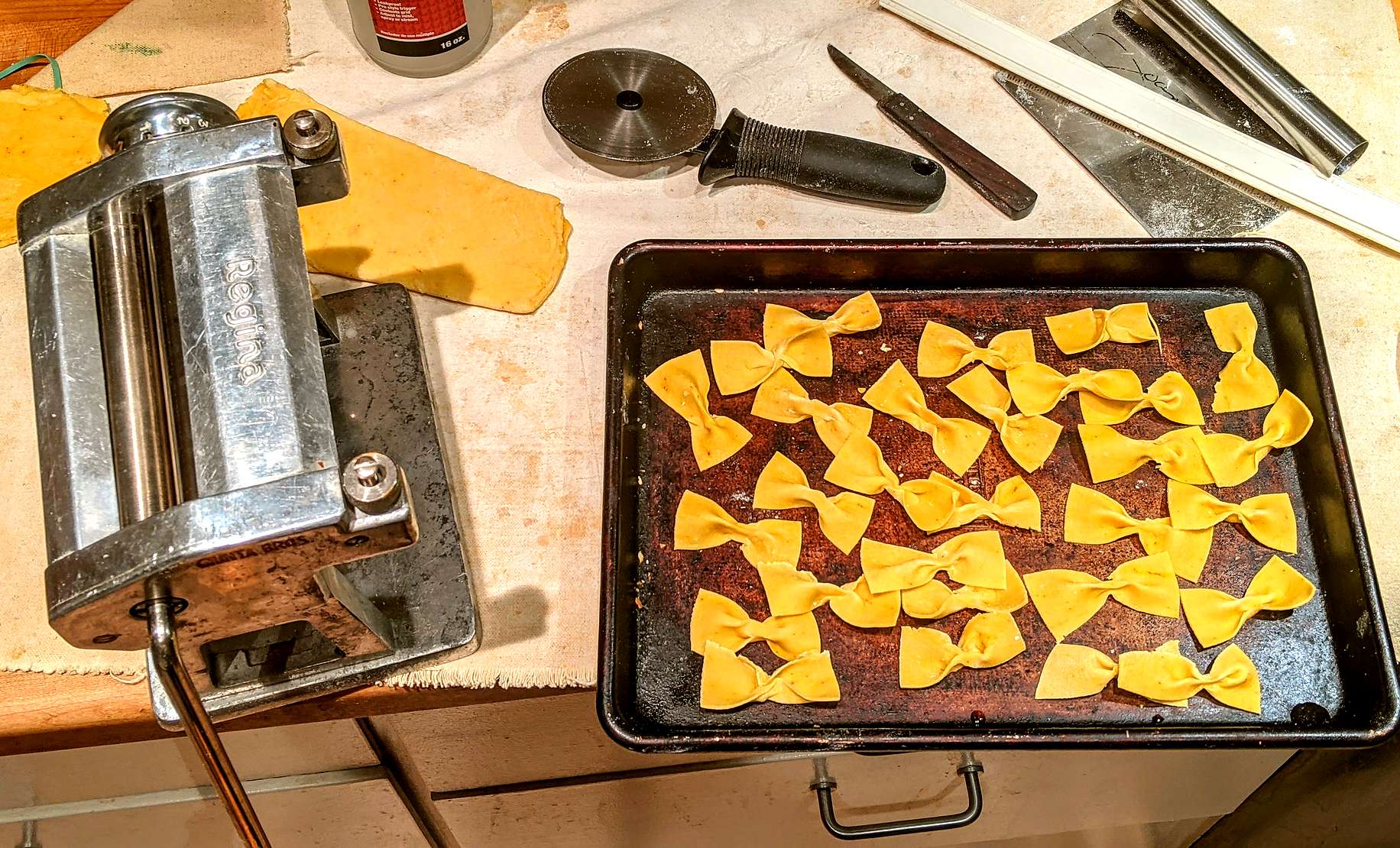When our garden was hit with the first killing frost (and four inches of snow) on Halloween, we were lucky. We had harvested all our green tomatoes and a bucket of partially ripe cherry tomatoes before the mercury plunged. So we will still be cooking with fresh tomatoes for another week or so.
But end-of-the-season tomatoes can’t hold a candle to the sweet, juicy beauties of summer. Ditto the greenhouse tomatoes that we buy over the winter. Every year we talk ourselves into their virtues and overlook their faults. At some point great canned tomatoes are superior to just okay fresh ones.
Finding the best canned tomatoes in the world
 We look for cans labeled ‶Pomodoro San Marzano dell’Agro Sarnese-Nocerino DOP.″ Sometimes it’s a subtitle of the main brand, sometimes it’s just listed in the ingredients. The cans contain probably the best tomatoes in the world grown specifically for the canning trade. They are an elongated plum tomato that grows in thick clusters on vigorous bush-like plants. Tomatoes called ‶San Marzano″ are grown all over the world, and they may hail from the same seed stock. But only those cultivated in the volcanic soils of the 41 towns of the Agro Sarnese-Nocerino area east of Naples have the special flavor.
We look for cans labeled ‶Pomodoro San Marzano dell’Agro Sarnese-Nocerino DOP.″ Sometimes it’s a subtitle of the main brand, sometimes it’s just listed in the ingredients. The cans contain probably the best tomatoes in the world grown specifically for the canning trade. They are an elongated plum tomato that grows in thick clusters on vigorous bush-like plants. Tomatoes called ‶San Marzano″ are grown all over the world, and they may hail from the same seed stock. But only those cultivated in the volcanic soils of the 41 towns of the Agro Sarnese-Nocerino area east of Naples have the special flavor.
Although the seed line originated in the northeast coast of South America, San Marzano tomatoes all trace their lineage to the 1770 gift of seeds from the Viceroy of Peru to the King of Naples. That was more than two centuries after other tomato ecotypes (slicers, cherries) made their way from the New World to the Old. Recognition of the special quality of San Marzano tomatoes came about in 1996, when they were awarded a DOP (denominazione di origine protetta) designation. Just as California produces some excellent wines from the Pinot Noir grape, it cannot make Burgundy. Likewise, some California canned tomatoes may be good, but they’ll never be San Marzano DOP. For more information, see the Italian/English website https://ilovesanmarzanodop.com/
San Marzano DOP tomatoes are priced on a par with other Italian tomatoes. But they do require searching out, which makes them kind of special. We decided to highlight the rounded flavor and brassy finish of these tomatoes by making a Sicilian-style dish inspired by friend and cookbook author Michele Scicolone (http://michelescicolone.com/). We decided to dress it up a bit by making homemade saffron-garlic farfalle. It’s the dish at the top of this post.
SAFFRON FARFELLE ALLA SICILIANA
FOR PASTA
pinch of saffron threads
1/4 teaspoon salt
1/2 teaspoon garlic powder
1 1/3 cups (190 grams) all-purpose flour
2 large eggs
1 tablespoon olive oil
FOR SAUCE
1/4 cup olive oil
2 cloves garlic, finely chopped
pinch of crushed red pepper
28 ounce can San Marzano DOP tomatoes
1/4 cup golden raisins
salt and freshly ground black pepper
2 tablespoons salt for cooking water
1 broccoli crown, cut into small florets
1/4 cup roasted pistachio nutmeats, coarsely chopped
Make the pasta.
Start by grinding saffron, salt, and garlic powder in a mortar and pestle until the mix is a fine powder. Add a tablespoon or so of flour and continue grinding until thoroughly blended. Add the mix to remaining flour in a large bowl. Make a well in the center and add eggs and olive oil. Using a fork, whip the eggs and blend into the flour until you have a crumbly mixture. Turn out of bowl and knead until dough is smooth and reaches earlobe texture. Roll out with a pasta machine or rolling pin. Cut dough into 1 inch by 2-1/4 inch rectangles. Pinch each in middle to form bowties and set aside while making sauce.
Make the sauce.
In a large skillet (a chicken cooker works well) heat olive oil and add garlic and crushed red pepper. Cook over medium heat until garlic is golden brown. Spoon whole tomatoes out of can with a slotted spoon and add to skillet. Continue cooking, breaking up the tomatoes with a slotted spatula. After about 5 minutes, add remaining juices and pulp from can. Stir often while cooking for at least 20 minutes as sauce reduces and begins to thicken. Add raisins and salt and pepper to taste and remove from heat.
Finish the dish.
Bring four quarts of water to boil in a large pot. Add salt and broccoli florets. Bring back to a boil and cook for 1 minute. Place farfalle into boiling water and cook an additional 2 to 2-1/2 minutes. Drain broccoli and pasta and toss with hot sauce. Serve in shallow bowls with generous sprinkling of chopped pistachios.


